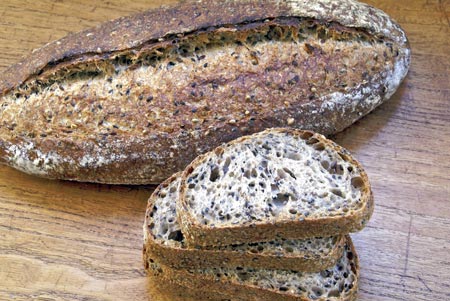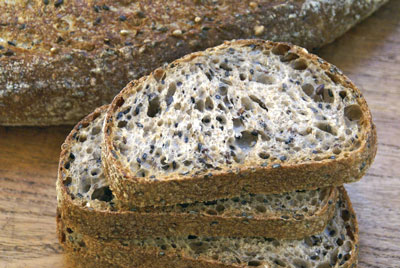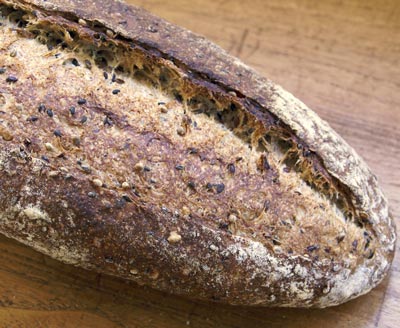
This is a bread we made in class (way back in the halcyon bread days, before butter and sugar commandeered my educational life).
I modified the formula to use liquid instead of stiff levain. I removed the small amount of instant yeast, and increased the fermentation and proof times accordingly. I used a different seed mixture and slightly increased the amount of whole grain flour. I added an autolyse (rest period after fours are mixed with water and starter).
So is this the same bread we made in class? Here I turn to G. W. F. Hegel, who said, “Identity is the identity of identity and non-identity.” That clears things up nicely, doesn’t it?

Seeded Multigrain Sourdough
Yield: 1000 g (2 loaves)
Time:
- Soak soaker: 30 minutes
- Mix final dough: 40 minutes (includes a 30-minute autolyse)
- First fermentation : 2.5 hours with folds at 50 and 100 minutes
- Preshape, rest, and shape: 35 minutes
- Proof: 2 – 2.5 hours
- Bake: 40 minutes
Desired dough temperature: 75F
Soaker Ingredients:
- 100 g mixed seeds (I used 40 g black sesame, 30 g flax, and 30 g hemp)
- 35 g rolled oats (not instant)
- 86 g water
Final Dough Ingredients:
- 240 g flour
- 94 g whole wheat flour
- 41 g coarsely-ground whole rye flour
- 227 g water
- 170 g mature 100%-hydration sourdough starter
- 9.5 g (1.5 t.) salt
- All of the soaker
Method:
- In a bowl, combine the soaker ingredients. Cover and let rest for about 30 minutes.
- Meanwhile, in the bowl of a stand mixer fitted with a dough hook, combine the final dough flours, water, and starter. Mix on low speed until combined into a shaggy mass. Cover and let rest for 30 minutes.
- Add the salt and mix on low speed. Add a little water if needed to achieve a medium-soft dough. Continue mixing on low or medium speed to a medium level of gluten development.
- Add the soaker and mix on low speed until the soaker is evenly incorporated into the dough.
- Transfer the dough to a lightly oiled container. Cover and ferment for 2.5 hours, with folds after the first 50 and 100 minutes.
- Turn the dough into a lightly floured counter. Divide into two pieces. Preshape each piece into a ball and let rest, covered, for 30 minutes.
- Shape the dough into batards and placethem, seam-side-up, in a floured couch or linen-lined baskets.
- Proof, covered, for about 2 – 2.5 hours, until the indentation left by a fingertip springs back very slowly.
- Meanwhile, preheat the oven, with baking stone, to 475F. You will also need steam during the initial phase of baking, so prepare for this now.
- Just before baking, make a single slash down the long axis of each loaf. Slashing slightly off-center will make the “ear” end up in the center of the loaf once the slash opens up.
- Once the loaves are in the oven, reduce the temperature to 450F. Bake for 8 minutes with steam, and another 20 minutes or so without steam. Then turn off the oven and leave the loaves in for another 10 minutes, with the door ajar.
- Cool on a wire rack.

Yummy!
That is a fine looking loaf! Very professional and quite inviting. All we need is cheese and wine. 🙂
Hi Susan, what is the difference between a liquid and a regular starter? I know it must have something to do with hydration. Thanks, and that is one beautiful multigrain bread.
I like the way you think… 🙂
That is exactly what I would like to do to a few of the breads from Bread Baker’s Apprentice: remove the instant yeast, add autolyse and increase fermentation time.
your bread turned out great, as usual – love the slashing!
I’ve got a question – sometimes I am too lazy to make the calculations to adapt the liquid levain to a stiff levain, or vice versa
do you think that one can get by with adjusting the water just by “feel” once the dough is mixed, and just use whatever levain is available at the moment?
Thta bread is splendid! It must be so flavorful!
Cheers,
Rosa
Gorgeous loaf Susan! Love all of those seeds.
Well done. 🙂
Beautiful loaves! That seed mixture sounds so good, I’m going to give this bread a try.
Hi Susan!
This bread looks wonderful! I’m day 3 into re-creating my starter – I’ve had such an itch to bake bread lately, and hopefully that will materialize in the next 2 weeks! Glad to see you’re still doing what you do best! I hope your SFBI training is treating you well!
xoxo
Melissa
Can I have a slice of that bread?
😉
Seriously, that is one very pretty loaf!
hey, i read your blog i want to tell you that it is wonderful the bread is great looking i also went to sfbi, it is the best training around, and looking at that bread proofs it, i didnt have the chance to take the whole 16 weeks, but what i learn is priceless, the only thing i really miss is the nann bread, if you ever get the chance to bake it , please write about it, takes pics, thanks, for your blog,
Beautiful, as always, Susan. Glad to see Hegel getting a mention.
Oh my. I think I need to bake this. I love seeds. I think you know that by now…
Beautiful loaf. I make a similar one, but use a combination of sunflower, sesame, flax and pumpkin seeds.
So I’m from Israel and can’t understand what’s hemp? Is there another name for that? I looked in wiki and could not understand. Thanks a lot, David
Just understand that we do not have them in Israel. Would you recommend a good replacement for the hemp seems?
Adriana, “liquid” is usually referring to a starter that has 100% or greater hydration; that is, the amount of water in the starter (and that is added at each feeding) is equal to or greater than the amount of flour, by weight.
Sally, when adjusting a recipe to use a starter of a different hydration, I like to keep the proportion of prefermented flour (i.e., the amount of flour contributed by the starter) the same. Therefore I wouldn’t just substitue an equal amount of the other starter. For example, if a recipe called for 90 g of 80% hydration starter, this would be made up of 50 g flour and 40 g water. Therefore, to get an equal amount of flour from a 100%-hydration starter, I would need 100 g of it (50 g flour/50 g water). It’s then pretty easy to see that the water in the final dough would have to be reduced by about 10 grams, since you’re getting more water coming along with that starter. But of course I always (meaning usually 🙂 ) recommend holding back a portion of the water in the final dough anyway, and adjusting “by feel.”
David, you can use pretty much any seed mixture you like. Poppy, pumpkin, sunflower, flax, and sesame are some that are readily available here, but if there are others more common in your part of the world, they would almost certainly work, too.
Great loaf, looks terrific and I would love to taste that!
I see what you mean. Indeed, it makes sense to think in terms of “pre-fermented flour” – because it is definitely not going to be the same as “flour” per se.
ok, the lazy route is definitely abandoned.
(sigh) 🙂
It looks and sounds delicious! Yum! There’s nothing like fresh bread!
Wow! Such lovely bread. I especially love any bread that’s seeded.
I’ve just baked 4 loaves and the results are fantastic!!
Thanks you so much.
David
Awesome crumb! That must have been so delicious with all of the seeds mixed into the sourdough flavor.
Tried this once as one rounded loaf and whoa! Beautiful! Now I’m gonna try to shaping the loaves, then retard overnight in the refrigerator to see if flavor develops even more. Very tasty and visually pleasing. Thank you!
Finally delurking to say many thanks! I baked this as one round loaf yesterday and am thrilled with the results; delicious with baba ghanoush! I’ve been using your recipes frequently, though always kneading by hand, and incorporating the soaker was pretty far out. I was a little suspicious that the crumb would collapse under the weight of the seeds, but no, total success. You’re very talented!
Wow! I made this recipe last night -just couldn’t wait although the bread is stacking up from all the recent experiments! This morning we enjoyed it, toasted, slathered in ripe avocado – deelish!
It’s so easy, beautiful, and tasty! Thanks for this!!
Wow..this one I have to try! Gorgeous!
Just wondering what the original formula was. I’d like to modify some formulas that call for a small amount of instant yeast, but don’t know how to increase the fermentation and proof times to make up for it. Would love to read some tips for this on your blog (ie. “adding so-and-so gm sourdough starter or yeast requires decreasing fermentation and proof times by such-and-such minutes whereas leaving out the starter or yeast requires an increase…”).
I just got my starter going about a month ago and followed your directions to bake bread over the weekend. I was amazed that such a beautiful loaf could come out of my oven and wanted to say “Thanks!”
Mike, I’m so glad you’ve had success with your starter! Since fermentation times depend on other factors besides the amount of yeast (type of flour, room and dough temperatures, etc.), it’s difficult to provide simple substitution rules. A “two o’clock” approach is always best: http://www.wildyeastblog.com/2009/06/09/two-oclock/
That said, for this formula, try adding 0.1% (about 3.8 grams) of instant yeast and expecting about 1.5 – 2 hour first fermentation and proofing times; see what happens!
I have now tried this recipe twice – the taste is the best EVER, so I really want to make it work, but on first attempt the dough was incredibly wet and sticky and the loaves barely rose. Second attempt, cut back on the water a little bit, increased flour a little bit, and it was kneadable first time round, but when it came to making loaves it was super-sticky again, and this time it was like bricks. No rising. I make sourdough bread all the time, so my starter is okay. I’m in New Zealand, so maybe the flours are different? I’d read about the importance of the proportions of pre-fermented/unfermented flour so didn’t want to change proportions too much. Suggestions, please!
Susan,
I LOVE this bread. The texture and taste turned out great. But a quick question for you. My loaves turned out rather flat, not nicely domed like yours are (see pics here: http://www.urbancholita.com/2010/08/best-bread-ever.html). Do you have any idea why that would be? Is that typically a sign of too much water? Also, I didn’t get a good ear. I used a serrated knife to make the slashes. Could that be why?
Urban Cholita, I think your loaves look wonderful. Flattening of the loaves and a “non-earing” cut can sometimes be due to overproofing or insufficient gluten development, but looking at you crumb, I doubt either of those was your problem. What’s more likely is that your loaves could be shaped a little more tightly. You want a nice taut surface. Shaping techniques are not something I’ve gone into too much on this blog, but hopefully I can do some videos soon.
Hi Susan,
Re your reply to Sally about adjusting starter hydration levels to recipes: 1. Does that calculation pertain only to the final refreshment of my starter? So if I’m refreshing my 100% starter in two feeds, I need only take care to ensure that the flour qty of the FINAL feed is equivalent to what is called for in the recipe?
2. what about the base/mother starter that you refresh? Is the flour & water quantities in this not taken into account at all? If I refresh my starter at a 1:1:1 (starter:flour:water) ratio, it seems to me that the amount of flour in the mother starter would be quite significant?
Thanks a lot! Your blog is always so helpful 🙂
I made this bread several days ago. Of course, it took several days to make, so I feel like I have been personally involved for some time 😉 It is fantastic, and that is with my messing with the poolish, and using corn meal rather than course rye, because that was what I had on hand. My son thought it was the best bread I have made in some time, high praise! It will be interesting to make it with rye, and to not be rushed as much as I was this time.
I took the SFBI course last summer and I thought the stiff starter multigrain was the star recipe. So happy to see your liquid starter version! Thanks!
Hi Susan, thank you so much for this recipe. I made this multigrain sourdough last night and it tastes divine today! I posted your recipe on my blog, and you can also see the bread’s photo:
http://smultronsoul.blogspot.com/2012/02/multigrain-sourdough.html
This bread is really good! Thank you so much for this recipe. I’ve used both white and rye sourdough starters and substituted whey (leftover from cheese making) for all the water. So, so good.
Thanks so much for this wonderful recipe! I’ve made this bread numerous times since I discovered your recipe last year….it is a family favorite! I make it as mini loaves (4 per recipe – I quadruple the recipe) that my kids use to make sandwiches with.
Hi Susan,
Is there any reason not to use the long, cold final proof technique that you describe in the Norwich Sourdough recipe for this one? I find that this really bring out the flavor.
Thanks,
Andrew
Oh yes, you can absolutely do that.
Hi
Can i use this for coldproving overnight without folds then?looks top notch
I m doing it with manitoba flour to get gluten higher
Thank you! I’m finally making the kind of bread I want to be baking! – baked this this morning after leaving in the fridge overnight – just delicious! Am going to try your Norwich one next!
Hi, thank you so much for this lovely recipe. I was wondering how I would go about changing it if I don’t have a mixer? (hand mix recipe)
First of all, the Hegel quote is killing me. Second of all, I tried this yesterday and I’m in love. I don’t have a standing mixer – it worked well enough by hand. I put in a quarter t yeast because I was nervous about my “levain” (we call it starter) and it certainly didn’t hurt. But what is a “couch”? Maybe mine would have ended up a little more vertical if I had done this rising in a “couch or linen lined basket” — which I don’t have and am not sure how to get. Tips welcome.
Could you bake these in loaf pans? If so, how long and at what temperature do I bake it? TIA!